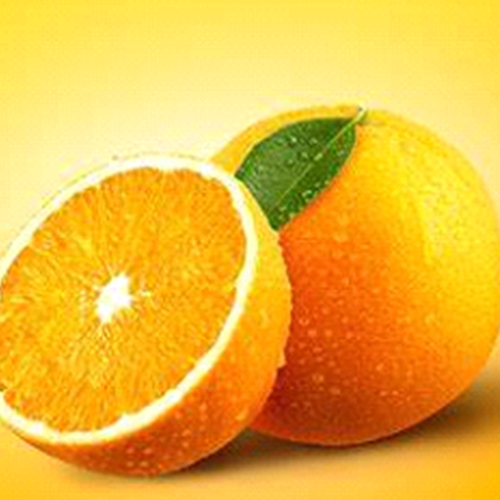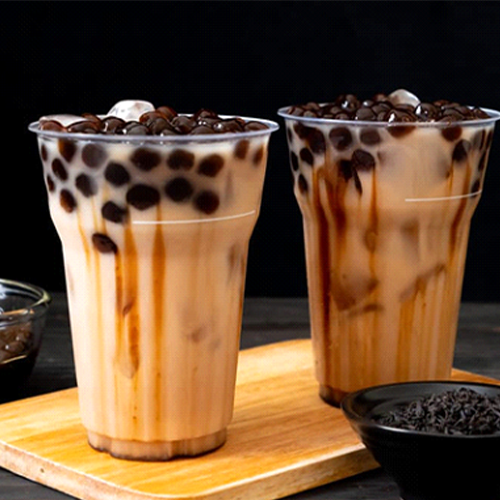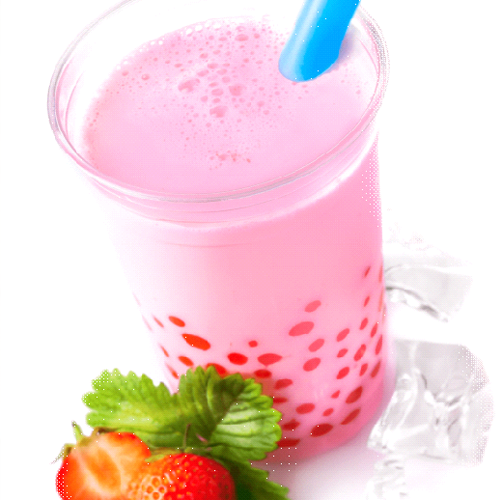Bubble tea, also known as boba tea, originated in Taiwan in the 1980s. The creation of this
popular beverage is often attributed to Lin Hsiu Hui, who added tapioca pearls to her iced tea
at a tea shop in Taichung. The concept quickly gained popularity and eventually spread
throughout Asia and beyond.
Here's a brief timeline of the history of bubble tea :
1. 1980s - Taiwan :
- The exact origins of bubble tea are a bit unclear, but it is widely believed to have
started in Taiwan in the early 1980s.
- The name "bubble tea" comes from the frothy bubbles that form when the tea is shaken.
2. Mid-1980s - Evolution of Tapioca Pearls :
- T• Initially, bubble tea consisted of sweet milk tea with tapioca pearls. Tapioca
pearls, also known as boba, were originally used in desserts. They were added to the tea
to create a unique and chewy texture.
3. 1990s - Global Spread :
- Bubble tea quickly gained popularity in Taiwan and other parts of Asia.
- By the 1990s, it had spread to other Asian countries, including Japan, South Korea, and
China.
Keep in mind that the shelf life can also be influenced by any added ingredients or preservatives, so
it's always a good idea to follow any recommendations provided by the manufacturer or supplier.
(2) HOW DOES ONE STORE BOBA ?
The storage of boba, whether fresh or dried, plays a crucial role in maintaining its quality and
preventing spoilage. Here are some general guidelines for storing boba :
Fresh Boba :
- 1. Refrigeration :
- If you have freshly made boba or boba with added moisture, store it in the refrigerator.
-
the boba in an airtight container or cover it with plastic wrap to prevent it from
drying out or absorbing Odors from the refrigerator.
- 2. Short-Term Storage :
- Fresh boba is best consumed within a few hours of preparation for the optimal texture
and flavour.
Dried Boba :
- 1. Cool, Dry Place :
- Store dried boba in a cool, dry place, away from direct sunlight.
- Keep it in a sealed container or the original packaging to prevent exposure to moisture
and maintain freshness.
- 2. Follow Package Instructions :
- Always check the packaging for any specific storage instructions provided by the
manufacturer.
General Tips :
(3) HOW TO COOK BOBA ?
Cooking boba, or tapioca pearls, is a relatively simple process. The exact cooking time and method
can vary based on whether you're using fresh or dried boba. Here are general guidelines for cooking
both types :
Cooking Fresh Boba :
- 1. Ingredients :
- Fresh boba pearls
- for boiling
- 2. Boiling :
- Bring a pot of water to a rolling boil.
- Add the fresh boba pearls to the boiling water.
- 3. Cooking Time :
- Boil the boba for 15 to 20 minutes or until they are fully cooked. The pearls will
become translucent when done.
- 4. Draining and Rinsing :
- Once cooked, drain the boba and rinse them under cold water to stop the cooking process.
- 5. Soaking in Simple Syrup (Optional) :
- For added sweetness, you can soak the cooked boba in a simple syrup or sugar water for
about 15-20 minutes.
- 6. Using Immediately :
- Fresh boba is best used immediately for the optimal texture and flavour.
Cooking Dried Boba :
- 1. Ingredients :
- Dried boba pearls
- Water for boiling
- 2. Boiling :
- Bring a pot of water to a boil.
- 3. Adding Boba :
- Add the dried boba pearls to the boiling water.
- 4. Cooking Time :
- Boil the boba for about 20 to 30 minutes. Stir occasionally to prevent sticking.
- 5. Checking for Doneness :
- Taste a pearl to check for doneness. The boba should be soft on the outside and chewy on
the inside.
- 6. Draining and Rinsing :
- Once cooked, drain the boba and rinse them under cold water to remove excess starch and
stop the cooking process.
- 7. Soaking in Simple Syrup (Optional) :
- Like fresh boba, you can soak the cooked dried boba in a simple syrup or sugar water for
added sweetness.
- 8. Using Immediately or Storing :
- Dried boba can be used immediately or stored according to the instructions provided by
the manufacturer.
Always refer to the specific instructions on the packaging of the boba you're using, as
cooking times may vary. Additionally, adjustments can be made based on personal preferences
for texture and sweetness.
(4) WHAT IS THE DIFFERENCE BETWEEN BOBA AND POPPING BOBA ?
"Boba" and "popping boba" are both terms associated with the world of bubble tea, but they refer to
different components of the beverage, each with distinct characteristics.
Cooking Fresh Boba :
- 1. Boba :
- "Boba" is short for "tapioca pearls." These are small, chewy balls made from tapioca
starch extracted from the roots of the cassava plant.
- Tapioca pearls are typically cooked and then sweetened, making them a popular addition
to various drinks, especially in bubble tea.
- Boba adds a chewy texture to the beverage and is often found at the bottom of the cup.
- 2. Popping Boba :
- "Popping boba," on the other hand, refers to small, juice-filled spheres that burst with
flavour when bitten or squeezed.
- Popping boba is made from a gel-like outer layer, often made from seaweed extract or
other plant-based materials, encapsulating a flavoured liquid centre.
- Unlike traditional boba, popping boba doesn't have the chewy texture of tapioca pearls.
Instead, it provides a burst of flavour when consumed.
- In summary, the primary difference lies in the texture and composition :
- 3. Cooking Time :
- Boba refers to the chewy tapioca pearls that add a unique texture to
bubble tea.
- Popping boba refers to small, juice-filled spheres that burst with
flavour when consumed, providing a different sensory experience compared to traditional
boba.
(5) WHAT ARE THE USES OF BOBA ?
Both boba and popping boba are popular toppings in bubble tea, and people often choose based on their
preference for texture and the additional burst of flavour that popping boba provides. Some bubble
tea drinks may even include a combination of both for a varied and enjoyable experience.
Boba, or tapioca pearls, are commonly used in a variety of culinary applications, and their uses have
expanded beyond traditional bubble tea. Here are some popular uses of boba :
(10) WHAT IS POPPING BOBA ?
Popping boba, also known as juice balls or bursting boba, is a type of novelty topping used in
beverages and desserts. These small, gelatinous spheres contain fruit juice or other flavoured
liquids inside a thin, flexible membrane. When you bite into them or apply pressure, the membrane
bursts, releasing the liquid inside.
Popping boba is often used as a topping in bubble tea, frozen yogurt, ice cream, and other desserts.
It adds a burst of flavour and a unique textural experience to the food or drink. The outer layer is
typically made from seaweed extract or other gelling agents, creating a delicate and chewy texture.
Popping boba comes in various Flavors and colours, allowing for creative and colourful presentations
in food and beverages. It has gained popularity for its ability to enhance the sensory experience of
a dish or drink.
(11) WHAT ARE THE USES OF POPPING BOBA ?
Popping boba is a versatile and fun ingredient that can be used in various ways to enhance the
flavour, texture, and visual appeal of different dishes and beverages. Some common uses of popping
boba include :
- 1. Bubble Tea (Boba Tea) : Popping boba is a popular topping in bubble tea, a
Taiwanese tea-based drink. It adds bursts of flavour and a unique texture to the drink. Popping
boba comes in various fruity Flavors, complementing the tea base.
- 2. Frozen Yogurt and Ice Cream Toppings : Popping boba can be used as a topping
for frozen yogurt and ice cream. It adds a burst of fruity flavour and a playful texture to the
creamy dessert.
- 3. Cocktail Garnish : Popping boba can be used as a creative and flavourful
garnish for cocktails. Drop a few popping boba into a cocktail, and as they burst, they release
their flavour, adding an extra dimension to the drink.
- 4. Mocktails and Beverages : Popping boba can be added to non-alcoholic
beverages, such as lemonades, iced teas, or sparkling water, to create refreshing and visually
appealing drinks.
- 5. Salads :Some chefs use popping boba as a surprising element in salads,
providing bursts of flavour amidst the greens and other ingredients.
- 6. Dessert Decorations : Popping boba can be used as a decorative element for
desserts, such as cakes, puddings, and fruit salads, adding colour, flavour, and a playful
texture.
- 7. Yogurt Parfaits : Popping boba can be layered in yogurt parfaits to create a
delightful and unexpected burst of flavour as you enjoy each spoonful.
- 8. Edible Decorations : Popping boba can be used as edible decorations for
various dishes, adding a visually appealing and tasty touch to the presentation.
- These are just a few examples, and the uses of popping boba continue to expand as chefs and
food enthusiasts experiment with this fun and versatile ingredient. Its ability to provide
bursts of flavour and a unique texture makes it a popular choice for those looking to add an
element of surprise to their culinary creations.
(3) WHAT ARE THE BENEFITS OF POPPING BOBA
Popping boba is primarily used for its unique texture and flavour-enhancing properties rather than
for specific nutritional benefits. However, its inclusion in certain dishes and beverages can
contribute to an overall enjoyable and sensory dining experience. Here are some potential benefits
of using popping boba :
- 1. Texture Variation : Popping boba provides a burst of liquid when bitten
into, creating a unique and enjoyable textural experience. This adds an interesting contrast to
the overall mouthfeel of a dish or beverage.
- 2. Flavour Enhancement : Popping boba comes in various fruity Flavors,
contributing to the overall flavour profile of a dish or drink. It can enhance the taste and
provide a burst of sweetness or tanginess.
- 3. Visual Appeal : Popping boba is available in a variety of colours, making it
a visually appealing addition to dishes and beverages. Its vibrant appearance can enhance the
aesthetics of a food or drink presentation.
- 4. Versatility : Popping boba is a versatile ingredient that can be used in a
wide range of culinary applications, from beverages like bubble tea to desserts, salads, and
cocktails. Its versatility allows for creative and innovative culinary creations.
- 5. Playful and Fun : The bursting sensation of popping boba can add an element
of playfulness and fun to food and drink experiences. This can be particularly appealing in the
context of desserts and beverages.
- While popping boba itself may not have specific health benefits, its use in moderation as part
of an overall balanced diet can contribute to a more enjoyable and diverse eating experience.
It's essential to be mindful of the overall nutritional content of the dish or beverage in which
popping boba is included, especially if it is paired with ingredients that may have nutritional
value, such as fruits or dairy products.
(12) IS POPPING BOBA GOOD FOR YOU ?
Popping boba, like many other food items, can be enjoyed as part of a balanced and varied diet.
However, it's important to note that popping boba is primarily a novelty topping used for its unique
texture and flavour, and it may not offer significant nutritional benefits. Here are some
considerations :
- 1. Calorie and Sugar Content : Popping boba is often sweetened, and the liquid
inside may contain sugar. If consumed in excess, it can contribute to added calories and sugar
in your diet. It's essential to be mindful of your overall sugar intake, especially if you are
watching your calorie or sugar consumption.
- 2. Artificial Ingredients : Some popping boba may contain artificial colours,
Flavors, and preservatives. If you have sensitivities or allergies to certain food additives,
it's important to check the ingredient list.
- 3. Dietary Restrictions : Popping boba is typically made with a gel-like outer
layer, which may include ingredients like seaweed extract or other gelling agents. If you have
dietary restrictions or preferences, it's advisable to check the product's ingredients to ensure
compatibility with your dietary needs.
- 4. Moderation is Key : As with many treats and toppings, the key to
incorporating popping boba into a healthy lifestyle is moderation. Enjoying it occasionally as
part of a well-balanced diet is unlikely to cause harm.
- If you have specific dietary concerns or health conditions, it's a good idea to consult with a
healthcare professional or a registered dietitian for personalized advice. They can help you
determine how popping boba fits into your overall dietary goals and whether it aligns with your
nutritional needs.
(13) WHAT IS THE BEST WAY TO SERVE POPPING BOBA
The best way to serve popping boba depends on the context and the type of dish or beverage you are
preparing. Here are some popular and creative ways to serve popping boba :
- 1. Bubble Tea (Boba Tea) : The most traditional and popular way to serve
popping boba is in bubble tea. Add them as a topping to your favourite tea base along with
tapioca pearls, ice, and milk (if desired). The burst of flavour from the popping boba adds a
delightful twist to the drink.
- 2. Frozen Yogurt or Ice Cream Topping : Sprinkle popping boba over a bowl of
frozen yogurt or ice cream. The burst of flavour and the contrast in texture work well with the
creamy base of these desserts.
- 3. Cocktail Garnish : Use popping boba as a unique and flavourful garnish for
cocktails. Drop a few into a glass of your favourite cocktail, and watch as they burst,
releasing their fruity goodness.
- 4. Mocktails and Lemonades : Add popping boba to non-alcoholic beverages like
mocktails or freshly squeezed lemonades. The bursts of flavour can turn a simple drink into a
fun and refreshing experience.
- 5. Salads : Introduce a surprising element to your salads by incorporating
popping boba. The burst of flavour can add a sweet or tangy note to complement the other salad
ingredients.
- 6. Yogurt Parfaits : Layer popping boba in yogurt parfaits for a playful and
flavourful twist. It adds a burst of excitement to each spoonful.
- 7. Dessert Decorations : Use popping boba as a decorative element for desserts
like cakes, puddings, or panna cotta. The vibrant colours and bursts of flavour can enhance the
visual appeal of your desserts.
- 8. Edible Decorations : Place popping boba strategically on a plate to create
edible decorations for various dishes. This can add a touch of creativity and playfulness to
your culinary presentations.
- Remember to consider the flavour and colour of the popping boba when incorporating it into your
dishes to ensure it complements the overall taste and aesthetics. Whether you're aiming for a
refreshing drink, a playful dessert, or a creative garnish, popping boba can add a unique and
enjoyable element to your culinary creations.
LIST OF PRODUCTS WITH IMAGE

Blueberry Popping

Kiwi Popping

Strawberry

Water Melon

Passion Fruit

Green Apple

Coffee

Mango

Peach

Litchi

Pineapple

Lemon

Orange

Coconut

Cranberry

Cherry

Custard Apple

Green Chilli

Saffron

Tamarind

Tomato

Bubble Cum

Cola
Special Order Products

Beer

Rum

Vodka

Whiskey




































